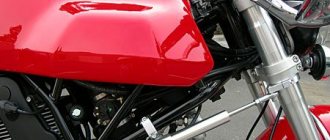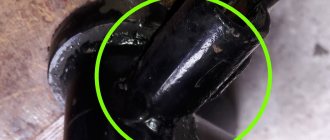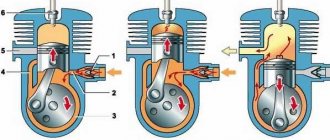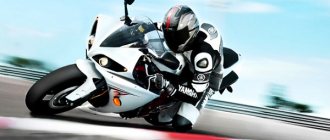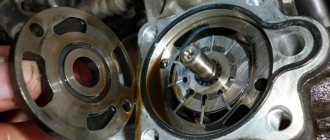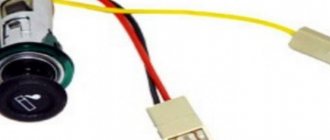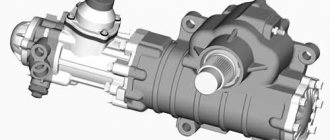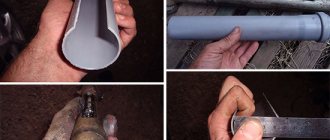The pleasure of driving a particular car is difficult to describe in words, but you can try to explain it by its design features. If we talk about the information content of the steering, then in addition to the architecture of the car’s chassis as a whole, the type of its amplifier plays an important role.
An uninformative or “wobbly” steering wheel, its poor self-return, weak feedback from the road, and so on - all these points depend primarily on the design of the steering system. Friction losses and parasitic moment of inertia play a fundamental role here.
steering
When choosing the type of power steering, it is better to focus specifically on driving sensations.
Hydraulic and electrical systems have serious design differences and their own strengths and weaknesses. When choosing the type of power steering, it is better to focus specifically on driving sensations. Hydraulic and electrical systems have serious design differences and their own strengths and weaknesses.
Where is the electric booster located?
The location of the electric power steering depends on how it is connected to the steering system. There are several ways:
- On the steering shaft using a worm gear;
- On the rail. Transmission is carried out through a gear;
- Parallel to the rail. Through a belt drive, the force from the electric motor is transmitted to the ball screw nut, which rotates the rack screw in the desired direction.
In the first case, depending on the layout of the vehicle components, the electric power steering may be located directly on the steering column or in the engine compartment , closer to the steering rack. Let us consider in detail all the ways to connect an electric amplifier.
Classic power steering
Classic power steering is still installed on many cars.
In addition to the presence of an expansion tank under the hood, it is immediately revealed by the appearance of the rack with hydraulic circuits. Classic power steering is still installed on many cars. In addition to the presence of an expansion tank under the hood, it is immediately revealed by the appearance of the rack with hydraulic circuits.
The main reasons for pump failure:
Untimely replacement of the working fluid in the system. Using a low-quality liquid or one that is not suitable for this car model. Ingress of dirt or foreign bodies (a clot of oily dust that usually accumulates around the oil reservoir cap is a common cause of pump failure). Lack of tightness and, as a result, leakage of working fluid. After which the system becomes airy and fails. Oil starvation due to kinks in oil lines. Significant overheating of the system, or systematic minor overheating. Errors during installation, poor quality assembly. During operation, the power steering pump parts, as they wear out, saturate the working fluid of the system with metal dust or even small metal particles. When the time comes to replace the old power steering pump with a new one, the entire power steering system must be thoroughly flushed, and elements in which wear products have accumulated must also be replaced. If you ignore this instruction, you risk that the new pump will be damaged as soon as possible.
admin 02/04/2015
“If you notice an error in the text, please highlight this place with the mouse and press CTRL+ENTER” “If the article was useful to you, share the link to it on social networks”
EGUR
EPS can be identified by the absence of a mechanical pump in the engine attachment drive.
The electric pump is separate. Today, many modifications of cars from the Renault-Nissan and GM concerns are equipped with such an amplifier. EPS can be identified by the absence of a mechanical pump in the engine attachment drive. The electric pump is separate. Today, many modifications of cars from the Renault-Nissan and GM concerns are equipped with such an amplifier.
Such a system has a separate control module. The trouble is that it is combined into a single assembly with a pump electric motor and its hydraulic part. On many older machines, the tightness of such a sandwich is broken and moisture or even oil itself gets into the electronics. This happens unnoticed, and when it comes to obvious problems in the operation of the amplifier, it is already too late to try to repair something. You will have to change expensive elements.
On the other hand, such a scheme with its own control unit, unlike the classic power steering, has an important advantage - a kind of “fool protection”. If for some reason there is a large oil leak from the system, it will turn off the pump itself, preventing its sudden death due to dry operation. As is the case with a classic hydraulic booster, any blood loss does not result in wear and tear of the elements in the rack itself.
Electric power steering (EPS) built into the steering column
With the advent of pure electric amplifiers, a parasitic moment of inertia was added to friction losses in steering mechanisms. Instead of hydraulics and a pump, electric motors came, built into the rack itself or standing outside it. Thanks to their rotation in one direction or another, assistance is provided when turning the steering wheel. However, the rotor of any electric motor has its own mass and, therefore, a moment of inertia. Therefore, it is impossible to instantly stop it and change the direction of rotation. Electronics need time to adapt. This moment is expressed in temporary additional resistance on the steering wheel when a person abruptly changes the direction of its rotation while driving.
Design features of electro-hydraulic power steering
The device consists of the following parts:
- pumping unit, which includes a tank with liquid and two pumps (electric motor and hydraulic). An electronic control unit is installed on this component;
- hydraulic control unit, consisting of a cylinder with a piston and a torsion bar;
- a control system that regulates the gain based on the vehicle speed and steering angle;
- an electronic unit that receives signals from sensors, analyzes them and, in accordance with them, acts on actuators according to established algorithms.
EUR
EUR with a worm drive built into the steering rack is easy to distinguish by appearance.
The electric motor is attached to its body next to the input shaft. EUR with a worm drive built into the steering rack is easy to distinguish by appearance. The electric motor is attached to its body next to the input shaft.
This view reveals a group of full electrical rails with built-in amplifier elements. In fact, such an electric power steering system has the same negative features when driving as in the previous example. The magnitude of parasitic friction losses and moments of inertia are similar.
During operation, the severity of malfunctions and the cost of repairs increases due to the fact that all elements of the amplifier are built into the rail.
Advantages and disadvantages of the device
The advantages of the mechanism include:
- efficiency - on average, fuel savings when using an electro-hydraulic booster is up to 0.8 liters of fuel for every 100 km. The reduction in consumption occurs due to the fact that the electric booster is not connected by a rigid belt to the engine, and at idle it stops working altogether;
- high reliability;
- minimal maintenance (the only thing that needs to be done is to change the fluid in the tank after a certain number of kilometers traveled);
- almost complete absence of noise during operation;
- the ability to program the device (for example, you can make it so that at low speed the force on the steering wheel increases, and when the speed increases, it decreases);
- high precision control at high speed;
- ease of maneuvering at low speeds.
But there are also disadvantages:
- high probability of failure of the electro-hydraulic booster when the wheels are in the extreme position for a long time;
- little information from the steering wheel when driving at high speed;
- high price of the device;
- failures in the settings (for example, there are often cases when, when parked, the wheels are twisted to the side instead of standing straight);
- The electrical component of the device cannot be repaired.
Of course, electric power steering is a new milestone in the development of cars, but at this stage the mechanism requires some modernization and refinement, which is why it is not yet installed en masse by manufacturers on their products.
Basic modes
The electric power steering has two main modes. They are characterized by the speed of the vehicle. In the first mode, when driving at low speed, for example, during parking, when greater maneuverability is required and the steering wheel has to be turned to the extreme positions, either left or right, the ESD applies maximum force to the steering mechanism, providing “light steering.” In this mode, you can rotate the steering wheel with one finger.
On the contrary, when driving at high speeds, the steering wheel becomes “hard”, creating the effect of the wheels returning to the middle position. This is done in order to improve traffic safety.
There are also modes for holding the car on the road in strong crosswinds, when driving on wheels, with different degrees of pumping. These modes are achieved thanks to special settings of the control unit. On business and premium class cars, the presence of an electric steering system allows you to implement the automatic parking option.
Pros and cons of power steering
The undoubted advantages of hydraulic boosters include the following:
- adaptability to high loads, which allows the use of power steering on heavy vehicles, including trucks;
- relative cheapness, which also affects the overall cost of the car;
- ease of machine control over a wide speed range;
- relative ease of maintenance and availability of repairs;
Power steering also has its disadvantages:
- engine power is used to operate the pump;
- the seals are easily damaged, as a result of which the system begins to leak;
- the efficiency of the hydraulic booster directly depends on the level of fluid in its reservoir;
- the fluid needs to be changed periodically;
- Power steering does not make it possible to individually adjust the performance characteristics of the steering system.
Advantages
- Compact. There are no additional units or mechanisms;
- Economical. The electric motor turns on only when the steering wheel is turned, it does not work constantly;
- It is cheaper to produce;
- More functionality;
- Easier to maintain.
Electric power steering is a new stage of development in the automotive industry. It not only helps the driver rotate the wheels, but is also involved in ensuring safe driving.
Many modern safety systems are based on it - ESP, lane keeping. Helps you park - automatic parking assistant. In the next article I will compare power steering and electric power steering. Let's look at their advantages and disadvantages and which one is the best.
About additional functions of electric amplifiers
The electric power steering device is designed in such a way that, if necessary, the electric motor can turn the car's wheels both simultaneously with the driver and independently. This gives scope for the implementation of additional functions:
- automatic “steering” to keep the car on a straight path;
- returning the wheels to a straight position after making a maneuver, the EUR can do this when the driver releases the steering wheel after making a turn;
- creating “heaviness” on the steering wheel in different driving modes to make the steering wheel more informative;
- perform automatic parking without driver intervention.
At the same time, the EUR does not interfere with direct control of the wheels when the engine is turned off or broken down; the mechanical connection between them and the steering wheel is maintained.
EPS malfunction
EPS fault pictogram
If the warning light on the instrument panel (the icon with the steering wheel with an exclamation mark) comes on, this indicates an EPS malfunction. The appearance of an error indicates that the electric amplifier does not undergo self-diagnosis when the ignition is turned on. The cause of the malfunction can be many factors, for example, the failure of any of the sensors included in the EPS control system. Although you can drive a car without an electric booster, you should not do this. It's better to turn to specialists.
